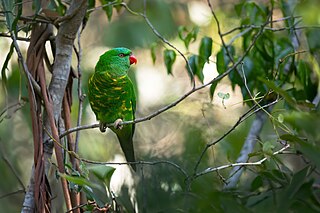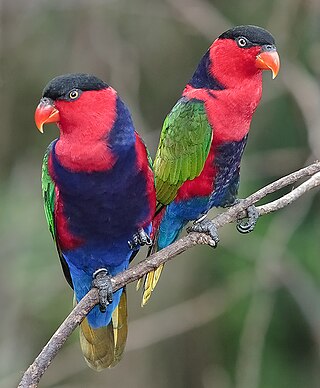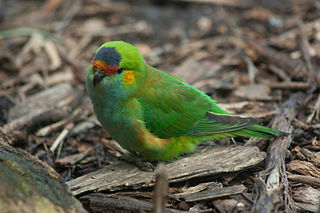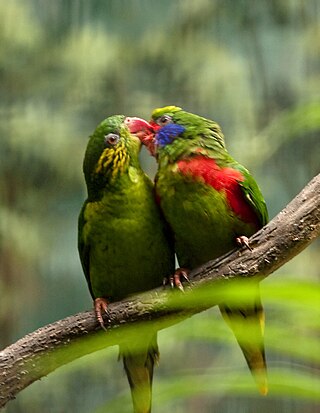
The scaly-breasted lorikeet is an Australian lorikeet found in woodland in eastern Australia. The common name aptly describes this bird, which has yellow breast feathers broadly edged with green that look like scales.

The New Caledonian lorikeet is a potentially extinct lorikeet endemic to the Melanesian island of New Caledonia.

Fuertes's parrot, also known as the indigo-winged parrot, is an Endangered species of bird in subfamily Arinae of the family Psittacidae, the African and New World parrots. It is endemic to Colombia.

The chestnut-breasted mannikin, also known as the chestnut-breasted munia or bully bird, is a small brown-backed munia with a black face and greyish crown and nape. It has a broad ferruginous breast bar above a white belly. The species is found in Australia, New Caledonia, Indonesia, and Papua New Guinea. This species has also been introduced to French Polynesia.

The black-capped lory also known as western black-capped lory or the tricolored lory, is a parrot found in New Guinea and adjacent smaller islands. It is a colourful and relatively robust lory. There are seven subspecies, all with green wings, red heads and body around the wing, a black cap, grey-black cere, yellow underwings, and blue legs and belly. Most also have a blue nape and mantle. It remains overall widespread and common, but the subspecies cyanuchen is relatively rare, with fewer than 5,000 individuals remaining.

The purple-crowned lorikeet, is a lorikeet found in scrub and mallee of southern Australia. It is a small lorikeet distinguished by a purple crown, an orange forehead and ear-coverts, and a light blue chin and chest.

Josephine's lorikeet is a species of parrot in the family Psittaculidae. It is found in the highlands of New Guinea . Its natural habitats are subtropical or tropical moist lowland forest and subtropical or tropical moist montane forest.

Charmosyna is a genus of parrots in the family Psittaculidae. The three currently recognized species inhabit moist forests on the island of New Guinea.

The duchess lorikeet is a species of parrot in the family Psittaculidae. It is the only species placed in the genus Charmosynoides. It is found throughout the Solomon Islands archipelago. Its natural habitats are subtropical or tropical moist lowland forest, subtropical or tropical moist montane forest, and plantations. It is threatened by habitat loss.

The West Papuan lorikeet is a species of parrot in the family Psittaculidae. It is found in New Guinea. Its natural habitat is subtropical or tropical moist montane forests.

The red-flanked lorikeet is a species of parrot in the family Psittaculidae. It is found in Mollucas, New Guinea and the Bismarck Archipelago. Its natural habitats are subtropical or tropical moist lowland forests and subtropical or tropical mangrove forests. Only the adult males have the red plumage on the head and sides.

The fairy lorikeet is a species of parrot in the family Psittaculidae. Other common names include the little red lorikeet and the little red lory. Found in New Guinea, its natural habitats are subtropical or tropical moist lowland forests and subtropical or tropical moist montane forests. Its colouration is mainly red with some yellow on the throat and green on the wings. Two subspecies are recognised, C. p. pulchella and C. p. rothschildi.

The pygmy lorikeet is a species of parrot in the family Psittaculidae. It is the only species placed in the genus Charminetta. It is found in the highlands of New Guinea; its natural habitat is subtropical or tropical moist montane forests. The world population of pygmy lorikeets is thought to be less than 50,000 individuals, but stable. They live at altitudes of 1000–2200m.

The red-cheeked parrot is a species of parrot in the family Psittaculidae found in Indonesia, Papua New Guinea and the tip of northern Australia. There are 17 subspecies currently recognized. It is a stocky short-tailed parrot with predominantly green plumage. It exhibits sexual dimorphism; the adult male has red cheeks and a mauve nape and top of head, while the female is duller with a brown head.

The Geelvink pygmy parrot is a species of parrot in the family Psittacidae endemic to Biak and Numfoor islands in Western New Guinea. The name Geelvink comes from a Dutch ship and family called Geelvinck. It has two subspecies; the nominate occurs on Numfor, and M. g. misoriensis on Biak.

The orange-billed lorikeet is a species in the Old World parrot family Psittaculidae. First described by the German ornithologist Ernst Hartert in 1896, it is endemic to New Guinea, where it mainly inhabits cloud forest, forest edges, and cleared areas bordering forests at elevations of 2,100–3,800 m (6,900–12,500 ft). Adults are 18 cm (7.1 in) long on average and weigh 25–40 g (0.88–1.41 oz), and are mainly green in color, with a red underside and narrow yellow streaking on the cheeks. It looks similar to the closely related yellow-billed lorikeet, but is smaller in size, has more richly coloured plumage, and has a smaller, orange bill.

Stephen's lorikeet, also known as the Henderson lorikeet or the Henderson Island Lorikeet, is a species of parrot in the family Psittaculidae. It is endemic to Henderson Island in the Pitcairn Islands of the South Pacific.

Archbold's newtonia is a species of bird in the family Vangidae. It is endemic to Madagascar. Its natural habitats are subtropical or tropical dry forests and subtropical or tropical dry shrubland. The birds have a greyish brown back and tail, with a rufous forecrown and a buffy white belly, throat, and undertail coverts. They have a conspicuous rufous eye-ring, accompanied with a black bill and pale yellow eyes. The species is sexually monomorphic, and there is no major difference between the sexes. There is no breeding plumage for the males.

The coconut lorikeet, also known as the green-naped lorikeet, is a parrot in the family Psittaculidae. Seven species of lorikeets now recognised were once lumped together under Trichoglossus haematodus.



















